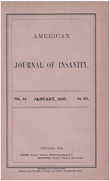Demographics, family history, premorbid functioning, developmental characteristics, and course of patients with deteriorated affective disorder
Abstract
OBJECTIVE: This exploratory study examined the characteristics of a group of unusual and previously undescribed patients with major affective disorder who not only had been continuously symptomatic for prolonged periods of time but were also so functionally impaired that they required years of continuous care in psychiatric facilities or by family members. METHOD: Twenty-seven inpatients with major mood disorders and 29 inpatients with schizophrenia were recruited from a large state hospital; 27 outpatients with major mood disorders were recruited from an affiliated outpatient facility. The research battery included the Structured Clinical Interview for DSM-III-R--Patient Version, the Premorbid Adjustment Scale, and a semistructured interview designed to assess demographic, family history, developmental, and course information. RESULTS: Inpatients with deteriorated affective disorder differed from outpatients with nondeteriorated affective disorder along several important dimensions, including family history of mental illness, birth-related problems, physical disorders in infancy, premorbid functioning, presence of mixed episodes and rapid cycling, and medication non-compliance between hospitalizations. Inpatients with deteriorated affective disorder differed from inpatients with schizophrenia on the Premorbid Adjustment Scale. Patients with bipolar affective disorder differed from those with unipolar disorder on many of the variables associated with deterioration of functioning. CONCLUSIONS: Birth-related problems, physical disorders in infancy, and poor premorbid adjustment in childhood and adolescence appear to play an important role in deterioration of functioning among patients with unipolar depression. Disruption in treatment because of medication noncompliance and the appearance of mixed episodes and rapid cycling are associated with functional decline in bipolar affective disorder. Several characteristics previously considered specific to deterioration of functioning in schizophrenia, such as a high rate of birth complications and poor premorbid adjustment, appear to be associated with functional deterioration among patients with major depression as well.
Access content
To read the fulltext, please use one of the options below to sign in or purchase access.- Personal login
- Institutional Login
- Sign in via OpenAthens
- Register for access
-
Please login/register if you wish to pair your device and check access availability.
Not a subscriber?
PsychiatryOnline subscription options offer access to the DSM-5 library, books, journals, CME, and patient resources. This all-in-one virtual library provides psychiatrists and mental health professionals with key resources for diagnosis, treatment, research, and professional development.
Need more help? PsychiatryOnline Customer Service may be reached by emailing [email protected] or by calling 800-368-5777 (in the U.S.) or 703-907-7322 (outside the U.S.).



